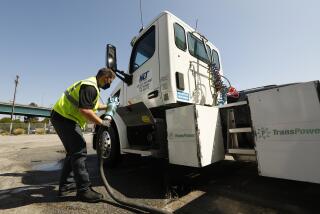State OKs strict air emission measures
Backing up tough actions taken by Los Angeles-area ports, state regulators Friday enacted a strict air emission measure that will ban much of the current fleet of diesel trucks from all ports statewide.
The California Air Resources Board will require all trucks to meet 2007 emission standards by 2014, an effort that mirrors a plan approved by the ports of Los Angelesand Long Beach.
The action came a day after the board required container, passenger and refrigerated vessels to reduce emissions while in port by either plugging into shore-side power grids or using alternative energy sources or fuels, such as liquefied natural gas, to run their lights, refrigeration, pumps and ventilation systems. Deadlines for those alternatives will be phased in beginning in 2010.
The measures, which apply to facilities in San Diego, Port Hueneme, Oakland and San Francisco, are the first of their kind in the nation and are expected to be duplicated by other states.
The ports of Los Angeles and Long Beach account for more than 40% of all containers entering the United States. Trade is expected to double or triple in the next 15 years.
The Los Angeles Harbor Commission on Thursday approved a terminal expansion that would increase ship calls by 30% and add 1,800 daily truck trips, but it included tight restrictions on emissions.
Idling ships accounted for 1.8 tons per day of diesel particulate matter statewide in 2006, according to the air board.
The diesel-truck regulation will affect the roughly 20,000 truckers who frequent the state’s six major ports and rail yards. By the end of 2009, all trucks manufactured before 1994 -- a large portion of the current fleet -- will have to be replaced, and trucks will have to reduce diesel emissions by a total of 85%.
Diesel emissions have been tied to increased risk for lung cancer, asthma and respiratory disease. A board study estimated that the regulations will prevent more than 1,200 premature deaths from 2009 through 2020.
“In our final meeting of the year, we really took on some of the biggest issues in air pollution that California has dealt with in years,” said board Chairwoman Mary Nichols. “These port rules have been talked about, or hoped for, for many years.”
The board’s regulations act as a backstop and complement to the local plans enacted in November, which require all trucks to meet 2007 emission standards by 2012, two years earlier than the measures approved Friday.
“Without the state regulation . . . they would just use these dirty trucks elsewhere in the state,” said Art Wong, a spokesman for the Port of Long Beach.
Officials expect the two regulations to cost more than $3 billion, and they have not determined how they will be funded.
Those costs sparked opposition from trucking and shipping interests. The majority of port truckers are independent owner-operators who make about $30,000 to $40,000 a year, according to board studies. Those truckers say the companies that contract them should be responsible for the cleanliness of the fleet.
“I cannot purchase a new truck, I cannot afford a new filter for a retrofit,” said Miguel Pineda, an independent trucker who spoke to the board in Spanish. He said most new trucks cost hundreds of thousands of dollars. “The trucker’s situation is deplorable,” Pineda said.
Meanwhile, trucking companies worry that the new regulations will spur unionization efforts. Shipping and trucking interests also warn of freight backups. At the ports of Los Angeles and Long Beach, officials in the next two weeks will consider adding a container fee to help pay for switching to a greener fleet.
“The cleanup effort needs to be borne by the polluters, but it will be ultimately passed on to the consumers, just like everything else is,” said S. David Freeman, president of the harbor commission.
Paying for the measures will probably intensify the debate over funding from Proposition 1B, a bond measure passed last year to fund transportation and air-quality improvements.
Meanwhile, a study released earlier this week by the Natural Resources Defense Council and the Coalition for Clean & Safe Ports found that diesel particulate measurements inside truck cabs were as much as 2,000 times greater than the level typically considered acceptable by state and federal environmental protection agencies.
Salvador Abrica has been a truck driver for five years and lives in Wilmington, less than a mile from the ports. “I come into a cloud, and that’s no place to live for anyone,” he told the board Friday.
“I want to breathe the sea breeze.”
More to Read
Start your day right
Sign up for Essential California for news, features and recommendations from the L.A. Times and beyond in your inbox six days a week.
You may occasionally receive promotional content from the Los Angeles Times.






